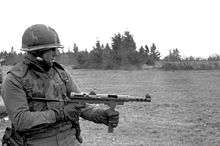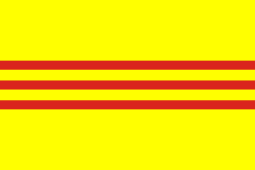Carl Gustav m/45
| Kulsprutepistol m/45 (Kpist m/45) | |
|---|---|
|
Carl Gustav m/45 on display | |
| Type | Submachine gun |
| Place of origin | Sweden |
| Service history | |
| Used by | See Users |
| Wars |
Vietnam War Congo Crisis Israeli-Arab conflict |
| Production history | |
| Designed | 1944 |
| Manufacturer |
Carl Gustafs Stads Gevärsfaktori Maadi Factories, Egypt |
| Produced |
1945–1964 (Sweden) 1965–1970 (Egypt) |
| Number built | approx. 300,000 |
| Variants | m/45, m/45B, m/45C, m/45BE, m/45BET, m/45S, Port Said, Akaba, US Navy modification (no official designation) with suppressor. |
| Specifications | |
| Weight | 3.35 kg without magazine |
| Length | 550/808 mm |
| Barrel length | 212 mm |
|
| |
| Cartridge | 9×19mm m/39B |
| Calibre | 9mm |
| Action | Simple (straight) Blowback |
| Rate of fire | 600 round/min |
| Muzzle velocity | 425 m/s |
| Effective firing range | 250 m |
| Feed system | 36-round box magazine |
The Kulsprutepistol m/45 (Kpist m/45), also known as the Carl Gustav M/45 and the Swedish K SMG, is a 9×19mm Swedish submachine gun designed by Gunnar Johnsson, adopted in 1945 (hence the m/45 designation), and manufactured at the Carl Gustafs Stads Gevärsfaktori in Eskilstuna, Sweden. The m/45 was the standard submachine gun of the Swedish Army from 1945 to 1965. It was gradually replaced in Swedish service by updated Ak 4 and Ak 5 assault rifles. The last official user of the m/45, the Swedish Home Guard (Hemvärnet), retired it from service in 2007.
The m/45 SMG was developed in 1944–45, with a design borrowing from and also improving on many design elements of earlier submachine guns. The sheet metal stamping techniques used in making the German MP 40, the British Sten, and the Soviet PPSh-41 and PPS-43 were studied in detail. Two designs were tested in 1944, one from Carl Gustafs Stads Gevärsfaktori and one from Husqvarna Vapenfabrik AB and the prototype from Carl Gustafs Stads Gevärsfaktori was chosen for further development. The first production version was adopted in 1945 as the Kpist m/45. The Danish Hovea M/49 SMG, although similar in appearance, is not a version derived from the m/45. The Hovea was a development of the failed test contender (fm44) from Husqvarna Vapenfabrik AB.
Due to its simple construction, copies made to the Carl Gustav design were crudely manufactured (without serial numbers) in small metal shops and by unofficial gunsmiths as cheap weapons used for crime in the early twenty-first century. The weapon was sometimes called the "Carlo".[1]
Features

The standard m/45 is a fully automatic only weapon without any option for semi-automatic fire. It weighs 3.3 kg (7.3 lbs.) unloaded, and 4.2 kg (9.25 lbs.) loaded with a 36-round box magazine. It is 808 mm (31.8 in.) long with the stock extended, and 550 mm (21.7 in.) long with the stock folded. The m/45 is an open bolt design with a fixed firing pin. The relatively slow cyclic rate of fire (550–600 rds/min.) and low recoil of the bolt-mechanism actuation (straight blowback) makes it easy to control during full automatic fire. Single shots are also easy to achieve (with very little training) by letting go of the trigger before another round is cycled. The m/45 is fairly accurate up to 200 meters.
Accessories include a special sub-caliber barrel (painted silver) for firing blanks and low-powered gallery ammunition. When firing blanks, a cone shaped blank firing adapter must be attached to the threaded muzzle of the sub-caliber barrel (and secured by a clip) to ensure the mechanism has adequate pressure for its blowback operation. Other accessories include night sights (war-time use only) that attach to the fixed day sights (f: protected post, r: L-type), a brass catcher for collecting spent cartridges (peace-time use only, for reloading and recycling), a quick-detachable (by attached cord) ejection port cover (painted bright red) for guard duty which secures the bolt from accidental firing and a speedloader (rarely issued due to limited availability) that loads the 36-round magazine in seconds. The m/45 was also issued with a standard cleaning kit containing a threaded cleaning rod, threaded jag and a container for the jag, lubricant and cleaning patches. The standard sling issued was made of leather, attached to the rear left receiver and left barrel-sleeve sling bars.
The 36-round straight detachable staggered row box magazine is wider at the rear than at the front, the extra space allows the 9mm Parabellum cartridges to feed more efficiently in dusty environments and sub-zero temperatures. The trapezium design makes the magazine very reliable, because magazines of parallel-side design are more likely to jam under adverse conditions. The magazine was used post-war by Finland in the m/31 Suomi under the designation m/54, a distinguishing feature of the variation m/55 (made by Lapua) is a steel wire carrying loop mounted at the bottom front edge. The basic design idea of the m/45 magazine was also used for the magazines of the Czech model 23 and model 25 and the French MAS submachine guns.
The m/45 has no safety switch. Instead the m/45 is put in "safe" by sliding the cocking handle into a short side-slot above the main (lock) slot. In the example US Army photograph, this short safety side-slot is visible behind the rear L-sight. This design feature results in a somewhat longer time to ready the weapon for firing, because the soldier must remove his right hand from the pistol grip and trigger, as if operating a bolt-action rifle. When the m/45 is unloaded the bolt is locked in place in the bolt-forward position by pushing the cocking handle inwards, engaging a hole in the lower left receiver wall.
Variants
- First production: the SMG models Kpist m/45 and Kpist m/45S featured a detachable (via removable clip) magazine support. It accepted the m/37-39 50-round "coffin" magazine and the later standard 36-round box magazine. Over time, most first production m/45's were converted by permanently riveting the magazine support to the receiver.[2] The m/45 had a dark gun metal finish.
- General production: the m/45B model features a fixed magazine support, smaller holes in the barrel shroud, a strengthened bolt buffer (in the receiver-rear), and a hook securing the buffer cap in place.[2] Early m/45B models had the same metal finish as the m/45 but most had a grey-green lacquer finish.
- Ceremonial and in UN/ONU: the m/45C is an m/45B with a bayonet mount on the barrel sleeve which was used for parade and guard duties. During the Congo Crisis in the 1960s, the Swedish UN forces used the C version extensively. The standard m/45 and m/45B have no bayonet mount.[2]
- Police: The Swedish police had the m/45 as a reinforcement weapon in their organization, but it was unlike the military model equipped with a switch for fully automatic or single shot. The police model designation was m/45BE (E = enkelskott/single-shot) and BET (T = tårgas/tear gas). The BET model become later escrow to the switch so that only single shot could be fired. BE model had the same finish as the military m/45 (black oxidized), but could be painted in black if the old finish had become too worn. It also received a modified stock in mid / late 70's (m/75) with a removable upper cheekpiece that allows the operator to wear a visored riot protection helmet (Huvudskydd m/69). BET model was painted black and would only be used to fire a tear gas canister(Tårgaskastspray m/74). To be able to shoot away the canister, a special propellant cartridge (9mm lös ptr m / T) had to be used. A red sticker on the left side of the weapon reminded the operator that they could only use that kind of ammunition. It also had a high front sight and an adjustable rear sight (30, 45 and 60 meters). The m/45 BET was replaced by Heckler & Koch MZP 1 (HP 40) in the early /mid 1990s because it was considered unfashionable and new tear gas canister was difficult to come by after that it contained the hazardous substance, Freon 12.



Manufacture and use
The Swedish Army list price of the Kpist m/45 was around SEK 600 in the late 1970s.
The Carl Gustav m/45 was replaced in the Swedish armed forces during the mid-1990s with the AK 4 and AK 5. On 2 April 2007 kpist m/45 was officially declared obsolete when it was retired from Hemvärnet who were the last users in the Swedish military.[3]
In addition to Sweden, several other countries have used the weapon, with versions of the weapon being produced in Egypt and the U.S:
Licensed production in Egypt
The m/45 has been manufactured under license in Egypt as the Port Said and the Akaba. The tooling needed for production, as well as technical assistance, was sold by Sweden to Egypt during the 1950s. The Port Said looks and functions exactly as the M/45 while the Akaba is a modified and simplified version. The Akaba has no barrel jacket and a slightly shorter barrel and the folding butt stock has been replaced by a telescoping wire butt stock similar to the one used on the US M3A1 and the French MAT-49 sub machine guns. The simplified sights of the Akaba were moved to the front (unprotected post) and back (protected peep) of the receiver.
Use by the United States in Southeast Asia
During the Vietnam War, the US Navy SEALs used the Carl Gustav m/45 SMG extensively. One of the gun's qualities which appealed to the US Navy was that the M/45 can fire almost immediately out of the water (over the beach). It also saw use by CIA operatives and advisers. In US service it was largely known as the "Swedish-K" or "K-Rifle".[4] The US Navy was so impressed by the m/45 that when Sweden embargoed the export of weapons to the USA in 1966, Smith & Wesson was given the task of producing a copy. This was designated the Smith & Wesson M76. However, by the time the M76 was ready for combat deployment, the US Navy interest had largely evaporated.[5] Many of the m/45s used by US forces and agencies were devoid of markings, implying clandestine use ("sanitized").
Users
 Algeria[6]
Algeria[6] Egypt: Manufactured locally under license as the Port Said and Akaba.[6]
Egypt: Manufactured locally under license as the Port Said and Akaba.[6] Estonia: Estonian Navy.[7]
Estonia: Estonian Navy.[7] Indonesia: Manufactured locally under license.[8]
Indonesia: Manufactured locally under license.[8] Ireland:[9] The Irish Army used the Carl Gustav M/45 during the Congo Crisis in the 1960s, during the Lebanese Civil War in the 1970s and during The Troubles. It was replaced in the Irish Army's inventory by the Steyr AUG, a compact assault rifle comparable in size to some submachine guns.
Ireland:[9] The Irish Army used the Carl Gustav M/45 during the Congo Crisis in the 1960s, during the Lebanese Civil War in the 1970s and during The Troubles. It was replaced in the Irish Army's inventory by the Steyr AUG, a compact assault rifle comparable in size to some submachine guns. Katanga: Small numbers, captured from UN troops
Katanga: Small numbers, captured from UN troops Latvia: National Guard
Latvia: National Guard Paraguay[6]
Paraguay[6] Sweden[8]
Sweden[8] United States[10]
United States[10]-
 South Vietnam
South Vietnam
See also
References
- ↑ Peter Beaumont (14 March 2016). "Homemade guns used in Palestinian attacks on Israelis". The Guardian. Retrieved 14 March 2016.
- 1 2 3 The submachine guns of Sweden. Retrieved 17 March 2008.
- ↑ [sv:Kulsprutepistol m/45]
- ↑ Bishop, Paul. "Karl Gustav M/45 "Swedish K"". MACV-SOG Living History Group. Retrieved 10 September 2013.
- ↑ World Guns' Smith & Wesson SW76
- 1 2 3 Jones, Richard D.; Ness, Leland S., eds. (January 27, 2009). Jane's Infantry Weapons 2009/2010 (35th ed.). Coulsdon: Jane's Information Group. ISBN 978-0-7106-2869-5.
- ↑ "Guns of Estonian Defence Forces". Retrieved 14 February 2015.
- 1 2 http://world.guns.ru/smg/swed/carl-gustaf-m45-e.html
- ↑ Hogg, Ian (2002). Jane's Guns Recognition Guide. Haper Collins. p. 223. ISBN 0-00-712760-X.
- ↑ T.L. Bosiljevac (1991). SEALs: UDT/SEAL operations in Vietnam. Ballantine Books. p. 114. ISBN 080410722X.
External links
| Wikimedia Commons has media related to Carl Gustaf m/45. |
- Carl Gustaf Kp M/45 submachine gun at Modern Firearms
